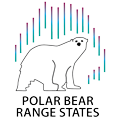10.5 Polar Bear Plasticity in a Changing Arctic
10.5 Polar Bear Plasticity in a Changing Arctic
Description
Presentation Title: Polar bear plasticity in a changing Arctic: dimensions and limits
Summary: Polar bears live only in areas that have sea ice cover for a significant part of the year. Although this suggests they will not be able to occupy areas where sea ice habitats no longer exist in the future, the fact that they occupy areas with a large range of ecological conditions at least on a seasonal basis today, indicates that this species does have a high degree of behavioral plasticity. The important questions is can this plasticity allow polar bears to survive in the conditions that will exist in the Arctic in the future, based on climate change predictions.. This presentation focuses on relevant knowledge gained from Svalbard, Norway, in recent years.
The Barents Sea subpopulation of polar bears occupies the area from Svalbard, Norway, in the west to Franz Josef Land (FJL), Russia, in the east, as well as the ice covered areas around these archipelagos and the sea ice north of the islands. This area has experienced sea ice losses at a rate higher than any other part of the Arctic, with a reduction of about 4 months of sea ice cover in the last three decades.
Although there are considerable amounts of data on various negative effects of habitat loss on polar bears in Svalbard (and elsewhere), population numbers indicate that this particular population has been increasing until recent, in response to protection from hunting that started in 1973. A fast losses of sea ice in traditionally important denning areas in eastern Svalbard have led to a large shift in where denning occurs. It is thought that a larger proportion of denning now occurs in FJL, compared to a decade ago. Females show impressive abilities to cross long stretches of open water. However, they do not do this to get to small isolated islands to den in the late autumn. It is perhaps too costly energetically for pregnant bears to do this sort of swimming, or females might avoid such areas because of the risk that such islands will be surrounded by open water when she must leave the den with small cubs the following spring. Most bears do follow the sea ice when it retreats northward in summer, and polar bears now occupy areas with deeper water, further offshore, which are assumed to be less productive. This results in longer distances to swim to reach land again after summer foraging. However, bears that undertake such “migrations” still seem to be in good condition most years in Svalbard.
Some polar bears stay in Svalbard year round, and hunt locally on the sea ice when it is available. Most of these bears live in the eastern parts of the archipelago where water masses are colder and sea ice is more extensive compared to fjords in the west, which are more heavily influenced by Atlantic Water that comes up the coast from the south. In western Svalbard, some polar bears do live year round in areas that frequently have sea ice only from a few weeks to a few months per year. These bears spend more time on land, and prey more on ground-nesting birds in summer. Some individual bears hunt harbor seals, and there are increasing numbers of reports of polar bears hunting reindeer successfully. These west coast bears do manage to survive and some produce cubs successfully. However, bears in NW Svalbard where loss of sea ice has been greatest are leaner than elsewhere in the archipelago, suggesting that a threshold might have been reached in this area.
In eastern Svalbard, polar bears used to spend a lot of time in front of glaciers both during the spring and summer - up until the early 2000s. In recent years, when sea ice has often been absent, the bears have shifted their summer foraging into terrestrial areas, and similar to west coast bears, they spend more time in ground-nesting bird colonies. This has occurred despite the fact that ringed seals have not changed their behavior with respect to glacier fronts; these areas are still preferred habitat. This infers a shift in this traditional Arctic predator-prey relationship.
The mating season for polar bears occurs in spring, but one observation of copulation in late June indicates some degree of plasticity that may be important in a changing Arctic. If females can become pregnant via late season breeding if they lose their cubs, it would shorten the period when she was without young, increasing reproductive potential of the population. Large variability in time of den entrance and den emergence documented recently, also indicates plasticity that may allow for fast changes in timing for when bears will find ringed seal pups in spring, if changes in sea ice conditions infer significant changes in reproductive timing of this important polar bear prey species.
In conclusion, data from Svalbard indicate a high level of plasticity in polar bears that will likely be important in a fast-changing environment. However, it is difficult to envisage stable polar bear population numbers in an Arctic with less sea ice. It will be important to study demography and behavior in different areas, across a wide range of conditions to increase our understanding of the conditions that might allow for polar bears survival in the future. Forward-looking planning of protected areas for polar bears in areas that are likely to maintain suitable habitat should already be under consideration based on climate change projections.
